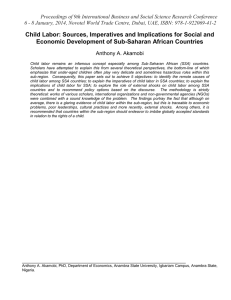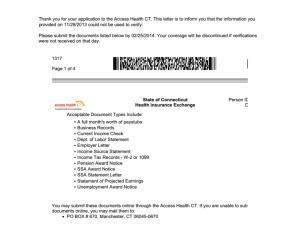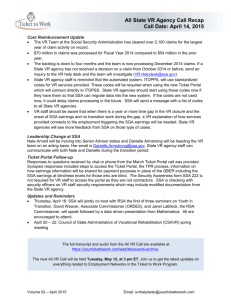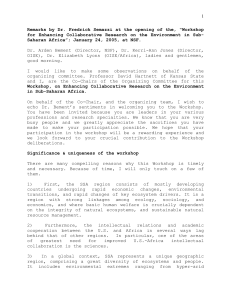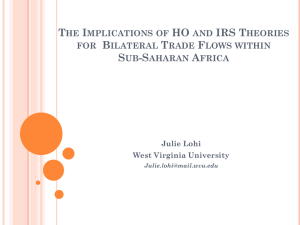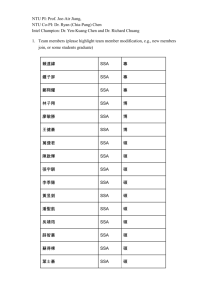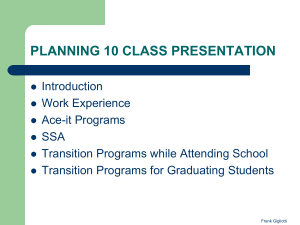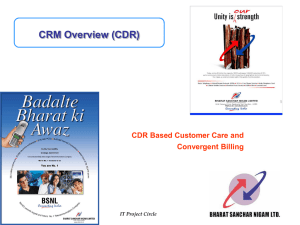Food Security and Sociopolitical Instability in Sub
advertisement
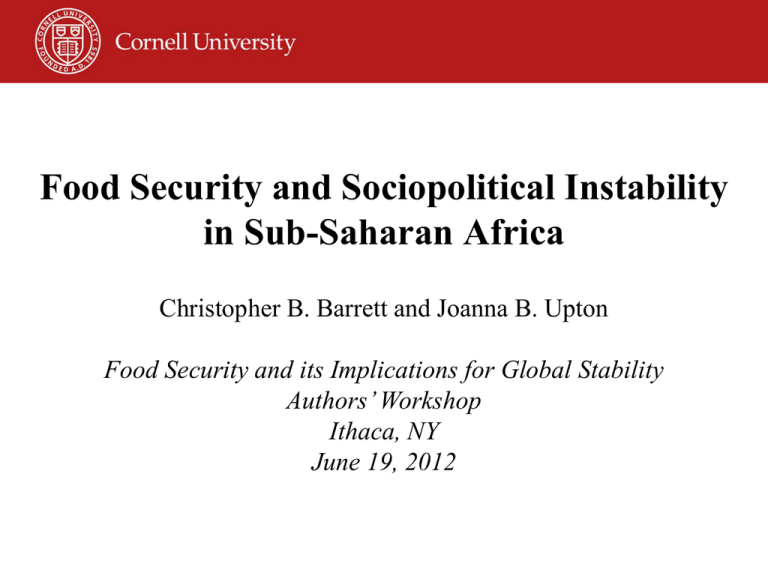
Food Security and Sociopolitical Instability in Sub-Saharan Africa Christopher B. Barrett and Joanna B. Upton Food Security and its Implications for Global Stability Authors’ Workshop Ithaca, NY June 19, 2012 Motivation Sub-Saharan Africa bears an unfortunate triple distinction among world regions: highest incidence of (i) undernourishment, (ii) ultra-poverty and (iii) conflictrelated deaths. Mutually reinforcing phenomena. Access ultimately key. SSA ultra-poverty (<$0.62 pc/day) stuck at ~20% … now 65% of world’s ultrapoor (up from 12% in 1981). 2007 Per Capita Nutrient Availability 47 Sub-Saharan African countries (shaded areas below minima) 90 Protein/day (grams) Uniquely, food availability limiting for 2/3 SSA nations. Increasing productivity crucial to SSA food security. 80 23.4% 34.0% 70 60 50 40 30 20 1000 6.4% 36.2% 1500 Source: FAO food balance sheets 2000 2500 Calories/day 3000 3500 Motivation Evolving conditions 1980-2000: sluggish, uneven progress. 2000-present: the “awakening lions” Looking forward: - continued rapid pop. growth and urbanization place added demands on food mktg systems - growing demand for land and water: potential for resource competition, esp. around “land grabs” - rising global prices + demand growth raises prospects of renewed urban unrest if gov’ts do not manage social safety nets effectively. Supply-side factors Agro-ecological Factors • Land and water abundant. But variable quality, often weak tenure security and diverse distribution and accessibility. • Very low uptake of modern ag tech. • Most African farmers are net food buyers Supply-side factors Agricultural productivity growth more in land (than labor) productivity, albeit less imbalanced than 1980-2000. International Comparison of Labor and Land Productivity 12 Sub-Saharan Africa, 2000-2009 US 10 A/L=27 A/L=8 ZA 8 A/L=4 NA GA 6 TD SD ML NG CV A/L=1 CMBJ GH CN SZ CI CG SO CF TG NE GWSL MG GN AO SN TZKE ZM DJZW LR LS BF ET ZR GM GQ MZ MU MW UG KM BI SC 4 ER 2 4 6 Food Production per Hectare (log scale) 8 KEY AO BF BI BJ CF CG CI CM CN CV DJ ET GA GH GM GN GQ GW KE KM LR LS MG ML Angola Burkina Faso Burundi Benin CAR Congo Côte d'Ivoire Cameroon China Cape Verde Djibouti Ethiopia PDR Gabon Ghana Gambia Guinea Equatorial Guinea Guinea-Bissau Kenya Comoros Liberia Lesotho Madagascar Mali MR MU MW MZ NA NE NG RE SC SD SL SN SO ST SZ TD TG TZ UG US ZA ZM ZR ZW Mauritania Mauritius Malawi Mozambique Namibia Niger Nigeria Réunion Seychelles Sudan Sierra Leone Senegal Somalia Sao Tome Swaziland Chad Togo Tanzania Uganda USA South Africa Zambia DRC Zimbabwe Demand-side factors Population very rural (64%) but growing/urbanizing fast. Demographic trend expected to continue. Trends in Urbanization Sub-Saharan Africa Percent Urban 2020 43 2010 37 2000 1980 33 24 In 8 of last 10 years, econ. growth in SSA > east Asia ! But very uneven growth among countries. Slowest in countries in protracted conflict. Sharp increase in global food market prices in 2008 and 2011 have nonetheless driven increased food insecurity in SSA.. Bridging supply & demand Markets – Accessibility: limited and poor quality road/rail infrastructure. High cost and delay. – Int’l Trade: net food deficit region. Yet unusually dependent on dom. production: >90% (vs. ~8587% globally). Landlocked countries near 95%. – Slow growth in domestic and regional food productivity combined with rapid growth in urban populations puts increasing stress on SSA’s food marketing systems. Globalization and new pressures Increased investment from new sources – BRIIC now comprise 20% of SSA trade (<1% in early 90s) – Chinese FDI presence esp. pronounced in rural areas Vulnerability to world price shocks – Oil – SSA net oil exporting region. But SSA ag is very vulnerable (esp. given distances/infrastructure) – Food prices (increasing populations exposed) Land investments (‘land grabs’) – SSA is principal target: 2009 deals of 39.7 mn ha (> ag land in Belgium, Denmark, France, Germany, the Netherlands, and Switzerland combined!) – 2008 Daewoo deal to lease 1.3 mn hectares led to gov’t overthrow in Madagascar. More to come? Globalization and new pressures Sociopolitical unrest /difficult political transitions – At least 14 countries suffered food riots in 2008. – Riots disproportionately in urban areas of coastal countries more heavily reliant on imported foods, with lower per capita domestic food productivity. – Gov’ts try to respond with trade and price policy measures to buffer impacts of price shocks. But gov’t capacity is quite uneven. – Pressures also around competition for natural resources, esp. land/water (Zim, Mali, Sudan, etc.). - Quite different pressures in rural and urban areas. Looking Forward: Major Drivers Africa will remain heavily dependent on smallholder farming and pop. @ risk of hunger grows by 2020-5. Demand Pressures => need for enhanced supply • Pop/income growth of 2.5/5% pa => 50% increase in food demand by 2025. • Even faster growth in mkt demand due to rapid urbanization (esp. in west/central SSA). Will put pressure on infrastructure and tensions over corporate control. Looking Forward: Major Drivers Opportunities to meet the challenge: • Land investments under equitable/transparent terms? • Technological advance: but little private or public R&D – GMOs – only SA and BF use them now – Irrigation – Soil fertility (organic fertilizers; integrated crop-livestock) Other trends worthy of attention… • Growing labor force (median age just 20 vs. 20 in Asia, 40 in Europe/NA)…but under potential strain of urbanization • Climate change and increased climate variability – esp. vulnerable to droughts and floods given poor water mgmt, spatial heterogeneity and weak mktg systems. Looking Forward: Key Indicators (1) Real Food and Fuel Prices – Prospective pressure on urban pop., esp. coastal nations (2) Urban Population Growth • Population density ; vulnerability to price volatility (3) Poverty • Change and spatial concentration (4) Land, Labor and Total Factor Productivity • Which crops ; distribution of benefits (5) GMO Diffusion • TFP improvements ; politicization and (proxy) conflict Looking Forward: Key Indicators (6) Water Resources – Change in availability. Flow, rainfall, irrigation patterns (7) Land Degradation – Soil nutrient loss (=> desertification) ; land restoration (8) Natural Disasters – Frequency/intensity ; poor institutional response capacity (9) Pests and Disease – Pre-harvest / production risks ; post-harvest / health risks (10) Land Investments (‘grabs’) – Equitable? Productivity/employment enhancing? Transparent? Summary Sub-Saharan Africa will likely remain the region most vulnerable to food insecurity and conflict. The big challenges turn on meeting the demands of rapid demographic change and economic growth. Low productivity combined with relative abundance of land/water and low rates of use of modern agr. technologies invite external interventions (land deals, GMOs, FDI) which need to managed effectively. Both challenges and opportunities abound. Thank you for your time, interest and comments!

